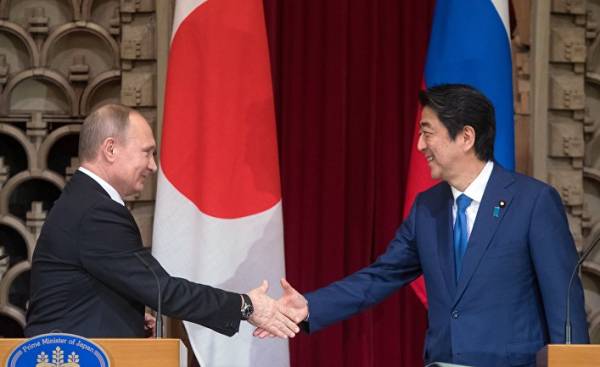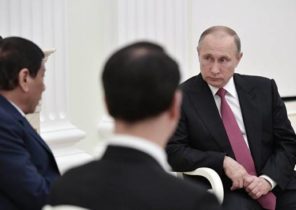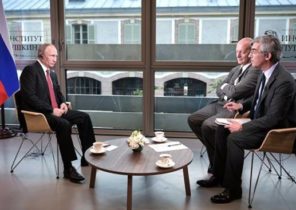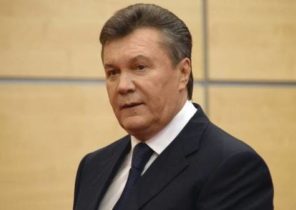
After a meeting in Vladivostok, Prime Minister Abe was in a good mood: he said that there were opportunities for the development of territorial negotiations. However, after a meeting in Lima, his facial expression changed. What, then, told him Putin? The answers should be sought in 1956, when it was restored Soviet-Japanese relations, but intervened in the case of the United States.
At a press conference, President Putin touched on “threats to DULLES”
In December last year, Japan hosted a meeting between President Putin and Prime Minister of Japan Shinzo Abe. Prime Minister Abe commented on the results: “We have agreed to start a discussion on special system for the implementation of joint economic activities on the four Northern Islands”. He also said: “the Start of discussions on a joint business is an important step to conclude a peace Treaty.”
Previously to the Japanese government a condition for concluding a peace Treaty, was the problem of “Northern territories”. It did not bring any tangible results. Basically, all the Japanese media emphasized that the territorial problem as there is no progress.
Nevertheless, I believe that there was not a single summit, which would be so clear to the Russian side’s attitude to the problem of “Northern territories.” It emerged during the joint press conference after a meeting of heads of Russia and Japan. To a journalist’s question, President Putin said: “for Example, in 1956 the Soviet Union and Japan came close to resolving the dispute and signed (and not only signed but also ratified) the 1956 Declaration, as we know. At the same time, the United States, who believe that they have interests in this region, almost the mouth of the then Secretary of state Mr. DULLES announced an ultimatum to Japan: if Japan does something that is contrary to the interests of the United States, then Okinawa will go entirely under the jurisdiction of the United States.”
Read more I’ll touch on this subject below, however, it is a historical fact that is called “DULLES threat”. Polka was driven such a wedge, the territorial problem between Russia and Japan was not moving at all. After a meeting with leader of Japan, which is a US ally, President Putin has officially said about the “threat DULLES.” This suggests that the conversation between the presidents of Russia and Japan were quite Frank, and also means that the parties shared historical perception and territorial issues.
The problem of “Northern territories” applies not only to Japan and Russia. It also refers to the relationship between Japan and the United States. And I think President Putin has repeatedly reminded the Prime Minister Abe about this historical shame.
In the approach of Russia and Japan to the “Northern territories” there are major differences. The Japanese foreign Ministry explained to the Japanese the following: “Despite the action of the Soviet-Japanese neutrality Pact, the Soviet Union violated the Treaty and continued to attack Japan after the surrender of illegally seizing the “Northern territories”. Currently, Russia actually owns these Islands.” In turn, Russia stated that it has legitimate rights to the Islands since the Soviet Union won the Second world war and the Islands were ceded to him the results of the war.
Consequently, Russia and Japan’s territorial problems.
Whose statements reasonable? From the point of view of historical facts right, Russia.
If we were to examine the course of post-war negotiations, the Cairo, Yalta conference, and so forth, “Northern territory” — a Soviet trophy. At that time Stalin demanded that Hokkaido was divided into Northern and southern parts, similar to Berlin, and to the Northern part became Soviet.
Who died from the disease, President Roosevelt replaced President Truman, who rejected the proposal on the division of Hokkaido. Instead, he suggested the southern part of Sakhalin and the Southern Kuriles. In other words, the United States said that the Soviet Union took the “Northern territories”.
With regard to the violation of the neutrality Pact and the beginning of the war against Japan, it also demanded President Roosevelt. Forces on the “Northern territories” delivered by the American battleship “Missouri”. It happened before September 2, Japan signed the surrender.
In other words, Japan and the USSR were still in a state of war, therefore, the seizure of the Northern territories cannot be called illegal. Moreover, the Russian side is perplexed: what could be a claim if all the inhabitants expelled without killing anybody?
It is 100% different from information of Japanese textbooks and the Ministry of foreign Affairs of Japan. Initially, the slogan “Northern territory — our native land” is a monstrous lie. The only thing that we can say that these territories belong to the Ainu (a people living on the island of Hokkaido — approx. ed.) but there is no evidence that the Islands are Japanese.
In accordance with international regulations on areas assigned by the war. If something does not suit, then they only have to return with military force. As for the “Northern territories”, that the Western coalition has admitted that they belong to Russia according to the results of the Second world war. Japan insists that it is originally a Japanese territory. This means that it does not recognize the results of world war II.
That is why Russian politicians and officials often say that Russia can’t conduct negotiations on a peace Treaty and the return of territories in light of the fact that Japan does not recognize the results of world war II. President Putin also has said: “the Starting point for negotiations is the recognition of the results of the Second world war”, but this time in the beginning he even mentioned “a threat to DULLES.”
“The threat DULLES” is an event that took place in August 1956 during the negotiations in London between Minister of foreign Affairs of Japan, Shigemitsu Mamoru (Mamoru Shigemitsu) and U.S. Secretary of state John foster DULLES. DULLES set a condition for the return of Okinawa: Japan must demand that the Soviet Union should return all four Islands at once.
Because the Soviet Union did not sign the San Francisco peace Treaty, diplomatic relations between it and Japan was restored in October 1956. Then the parties signed the Soviet-Japanese Declaration. Soviet Union and Japan failed to reach a compromise: after the signing of the peace Treaty Japan passed the Islands of Shikotan and Habomai. And then the United States intervened.
This is the “threat to DULLES.” In light of the worsening cold war, the rapprochement between the USSR and Japan, as well as the development of territorial negotiations seriously disturbed the United States. It is believed that the Japanese government was against the return of the two Islands, but somehow it is the “DULLES threat” was the reason that Tokyo began to demand the return of all four Islands. That is, President Putin has made it clear that the United States had a lot of pressure.
As a result, the USSR and Japan are unable to negotiate the territorial issue were shelved, and a peace Treaty was not signed.
A daring proposal as a condition for returning “Northern territories”
Meeting of heads of Russia and Japan were held in may in Sochi, in September in Vladivostok, in November in Lima and 12 times. After a meeting in Vladivostok, Prime Minister Abe was in a good mood: he said that there were opportunities for the development of territorial negotiations. However, after a meeting in Lima, his facial expression changed. What, then, told him Putin? Maybe the following:
“We can return at least two Islands. However, the sovereignty will go to Japan, with the result that the Islands fall under the Japan-us agreement in the field of security. If the US wants to place on the Southern Kuriles missiles, you will be able to refuse them?”.
Russia will not allow that to returned, the Isles were us military bases. Nevertheless, the government of Japan demanding that the country was defended up to the Senkaku Islands, will not be able to tell US that they eliminated the “Northern territories” of the security Treaty.
In this sense, the Minister of foreign Affairs of Russia Sergey Lavrov does not make mistakes, stating that the territorial negotiations did not develop, because Japan is an independent country that can make her own decisions. Perhaps that is what President Putin told the startled Japanese leader:
“After all, it is unreal. Initially, the US is put at stake return of Okinawa and prevented the return of the two Islands and to sign a peace Treaty. Japan accepted these terms and conditions, and your great-uncle, Eisaku Sato (Eisaku Sato), was returned to Okinawa. Maybe then we can discuss the return of the South Kuril Islands on the same terms?”.
As for the return of Okinawa, in addition to the “threats to DULLES,” was one additional condition that hides the Ministry of foreign Affairs of Japan: civilian power would be returned, but no military.
That is why Japan cannot make any claims if the Okinawa incidents occur or there place mine countermeasure ships USS Osprey. Part of this arrangement, known in Japan called the status of forces Agreement. However, the Japanese government never introduced to the Japanese explanation for this agreement.
There is no doubt that bold proposal of the President Putin’s return to civilian, but not military power on the island, to avoid the arrival of the us military bases, discouraged Prime Minister Abe, and then he realized the depth and complexity of territorial issues.
The head of Japan, who promised to resolve the problem of “Northern territories”, while vividly his generation, is forced to think through this issue alone and move to the next step. If you someone to consult, it may only do harm. According to rumors, the Secretary General of the national security Council of Japan, Shotaro Yachi (Syotaro Yachi) said high-ranking Russian official that in case of transfer of Japan of the Kuril Islands, there may be US military bases.
It is difficult to understand what is happening in the soul of Prime Minister Abe, who realized the depth of this problem.
During the summit in December, Russia and Japan have embarked on joint business activities in accordance with the “special system”. It can be assumed that the “special system” implies the return of Okinawa: the priority is given to economic activities in the division of sovereignty. That is, Putin and Abe shelved the territorial issue, which can cause a nervous reaction from the United States, and focused on the peace Treaty, as well as activities such as energy and tourism, which can bring dividends, not only Russia, but also Japan.







